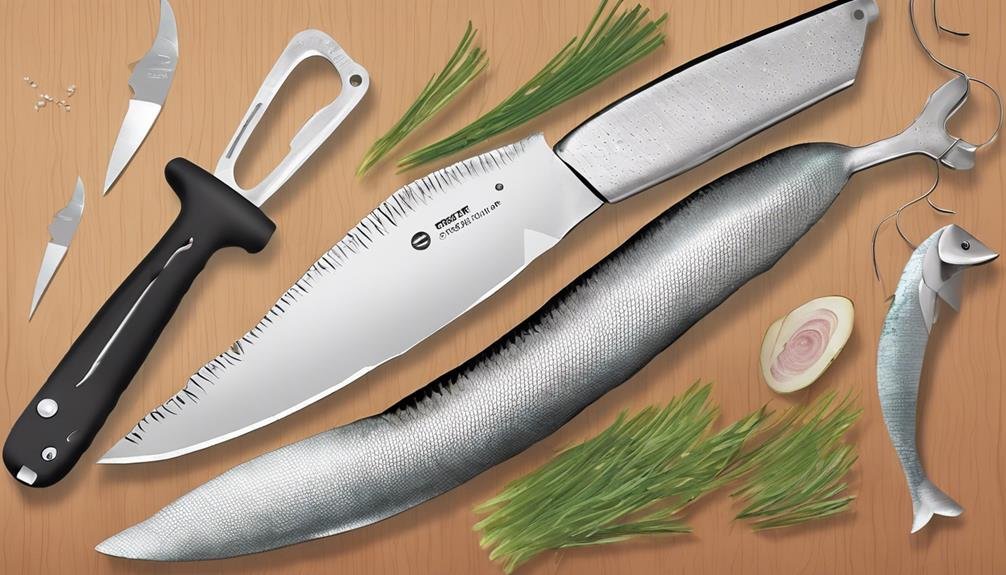When you think of a fishing knife, you may believe its purpose is solely for cutting fish. However, there’s more to it than meets the eye. The versatility of your multi functional fishing knife can surprise you with its range of functionalities. This tool can be your ultimate companion, from scaling and cleaning fish to assisting with various tasks on your fishing trip. So, are you ready to discover the untapped potential of your fishing knife and elevate your fishing game to the next level?
Key Takeaways
- Choose a multi-functional knife for diverse fishing tasks.
- Utilize the serrated edge for smooth filleting.
- Master using the bottle opener feature securely.
- Maintain knife sharpness for optimal performance.
- Enhance safety with proper handling and accessories.
Benefits of a Multi Functional Fishing Knife
Discover the potential of your fishing experience with a multi functional fishing knife that offers unparalleled versatility and convenience. When filleting fish, having the right tool can make all the difference. A multi-functional fishing knife excels in this task with its sharp blade and ergonomic design, allowing you to cleanly and efficiently fillet your catch with precision. The knife’s serrated edge guarantees smooth cuts through the fish’s flesh, while the sharp point lets you navigate through bones effortlessly.
With a multi-functional fishing knife, you no longer need to carry multiple tools for various fishing tasks. This consolidation streamlines your gear and reduces the risk of misplacing or forgetting essential tools. The convenience of having a single tool that can handle filleting fish, cutting lines, scaling fish, and even opening bottles can’t be overstated. Investing in a high-quality multi-functional fishing knife will enhance your fishing expeditions, making them more efficient and enjoyable.
How to Properly Clean Your Knife
When properly cleaning your fishing knife, it’s essential to use mild soap and warm water after each use to prevent corrosion.
Dry the knife thoroughly with a soft cloth to avoid any moisture-related damage.
Additionally, don’t forget to pay attention to hard-to-reach areas like the pivot point and handle scales for a thorough cleaning process.
Cleaning Materials Needed
To properly clean your fishing knife, ensure you have mild dish soap and warm water on hand for effective maintenance after each use. Keeping your knife sharp and rust-free requires proper care.
Dry the knife thoroughly after cleaning, especially if it’s made of carbon steel, to prevent rusting. Avoid soaking the knife or leaving it wet, as this can damage the blade over time.
Wipe the blade with an oil-soaked cloth to protect it from corrosion and maintain its sharpness. Store your clean and dry knife in a sheath or knife block to keep it sharp for your next fishing adventure.
Step-by-Step Cleaning Process
For a successful cleaning process for your fishing knife, start by rinsing off any visible debris and residue with warm water. Use a mild dish soap and a soft sponge to gently scrub the blade and handle, avoiding harsh abrasives that can damage the knife.
Dry the knife thoroughly with a clean cloth, paying special attention to the blade’s edge to prevent rust and corrosion. Store your clean and dry knife in a sheath or a knife block to protect it from damage and prepare it for your next fishing trip.
Importance of Rust Prevention Techniques
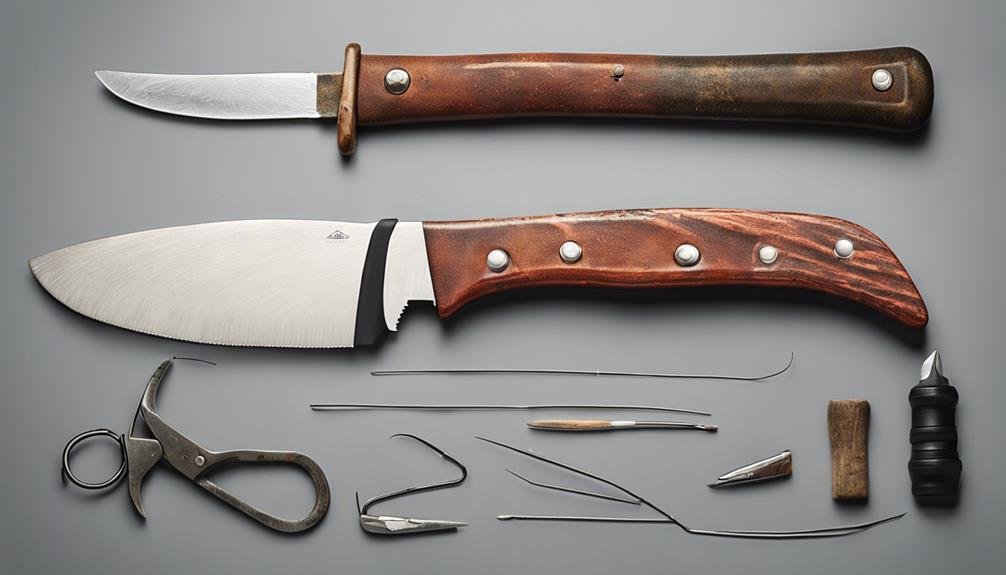
To keep your fishing knife in top condition, you must employ rust-proofing methods and maintenance tips. You can extend the lifespan of your knife by utilizing corrosion prevention techniques such as applying protective coatings and storing it properly.
Regular care and attention to rust prevention are key to ensuring your fishing knife remains reliable and durable for outdoor adventures.
Rust-Proofing Methods
Implementing effective rust-proofing methods is essential for maintaining the longevity and performance of your fishing knife. Consider applying a corrosion-resistant coating or rust-preventive oil to keep your knife sharp and rust-free.
Stainless steel knives are inherently more rust-resistant than carbon steel ones, making them a good choice for anglers. After each use, thoroughly clean and dry your knife to prevent moisture buildup.
Also, storing your knife in a dry place or using a protective sheath can shield it from rust-causing elements. By incorporating these rust-proofing techniques into your knife care routine, you can considerably extend the lifespan and functionality of your fishing tool.
Maintenance Tips
Proper upkeep of your fishing knife is crucial in safeguarding its longevity and performance, especially in preventing rust formation. After each use, clean your knife thoroughly, particularly if it has been exposed to saltwater. Remember to dry it completely to prevent moisture from causing rust.
A thin layer of food-grade mineral oil or a corrosion inhibitor can further protect the blade. Storing your knife in a dry environment and using a sheath or blade cover can also help prevent rust.
Inspect the knife for any signs of rust and address them promptly. Investing in a rust-resistant knife made of stainless steel or titanium can reduce the risk of corrosion and ensure your knife stays in top condition.
Corrosion Prevention Techniques
Preventing corrosion on your fishing knife is essential for preserving its longevity and maintaining peak performance, particularly in challenging environments like saltwater.
To keep your knife in top condition, thoroughly dry it after each use, especially if exposed to saltwater. Applying a light coat of oil, such as mineral or gun oil, creates a protective shield against moisture and salt, hindering rust formation.
To minimize corrosion risk, store your knife dry and avoid prolonged water exposure. To add an extra layer of protection, consider using a rust inhibitor designed for knives, particularly those used in marine environments.
These techniques will help safeguard your fishing knife, ensuring it remains a reliable tool for fishing expeditions.
Choosing the Right Blade Shape
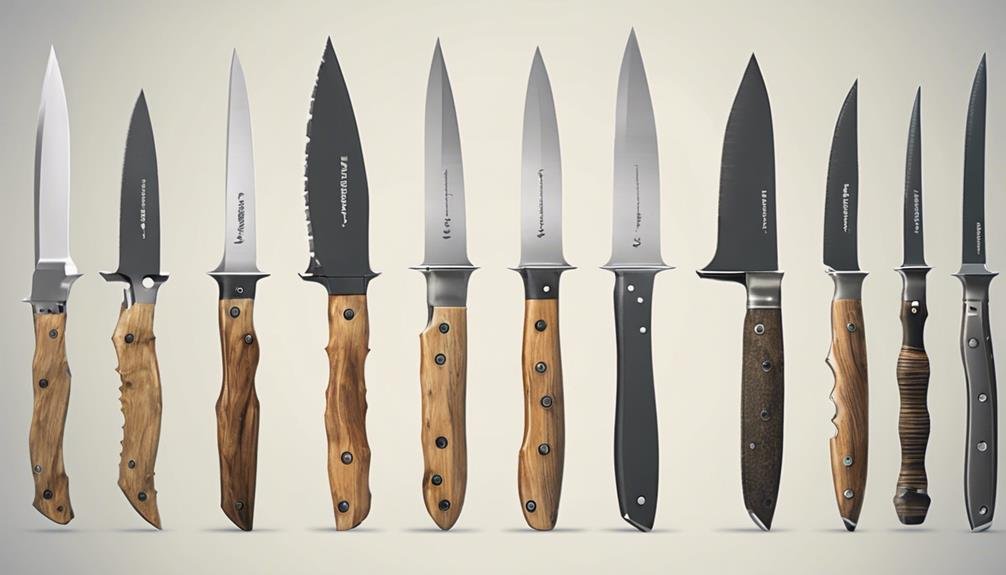
When selecting a fishing knife, the blade shape is crucial in determining its effectiveness for specific tasks such as filleting, scaling, and slicing fish. Different blade shapes offer unique advantages for various fishing purposes.
A curved blade, such as a trailing point or skinning blade, is perfect for easy precision cuts and skinning fish. On the other hand, a tanto blade shape provides strength and durability for heavy-duty tasks like cutting through tough fish scales or bones.
Consider the type of fishing you often do when choosing a fishing knife with the right blade shape to enhance your fishing experience. Whether you need agility for intricate cuts or power for tougher jobs, selecting the appropriate blade shape will ensure you can handle any fishing task efficiently.
Keep up the good job in exploring the diverse blade shapes available to maximize the potential of your fishing knife.
Using the Bottle Opener Feature Effectively
Use its bottle opener feature to maximize your fishing knife’s versatility. Remember to proceed with caution when utilizing this feature to prevent any mishaps. Some fishing knives come equipped with a durable and reliable built-in bottle opener, adding functionality to the tool.
Here are some tips to help you maximize the use of your fishing knife’s bottle opener:
- Secure Grip: When using the bottle opener, ensure a firm grip on the knife to maintain control and avoid accidents.
- Steady Pressure: Apply steady and consistent pressure when opening a bottle to prevent slipping and maintain efficiency.
- Proper Technique: Use the bottle opener as intended, following the instructions provided with your fishing knife to achieve the best results.
Maximizing the Knife’s Cutting Edge
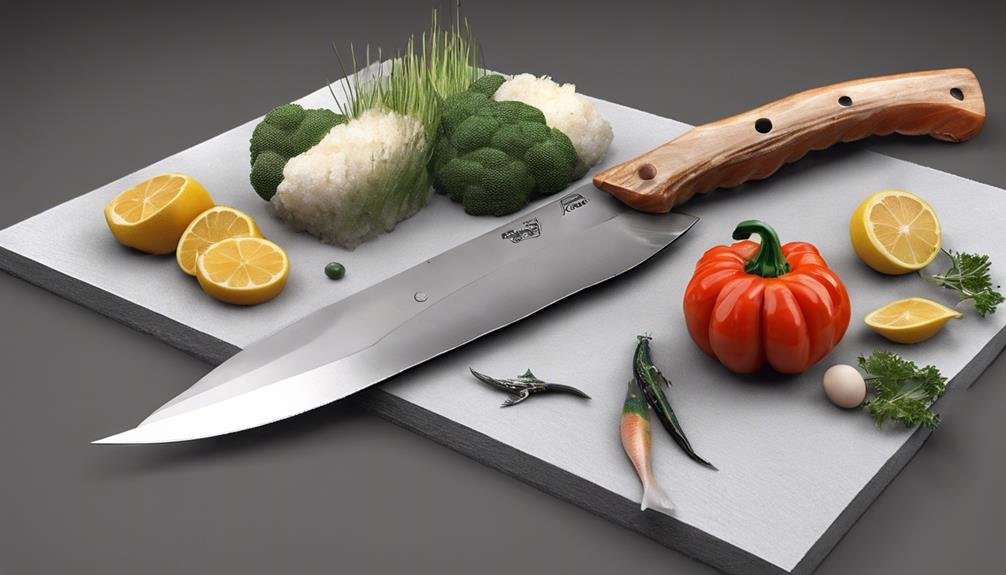
Maintaining a sharp cutting edge on your fishing knife is essential for precisely filleting and cleaning fish. Using the right tools and techniques is vital to guaranteeing your knife is always razor sharp. Regularly honing your blade with honing steel at the correct angle can help preserve its sharpness without wearing it down.
When your knife starts to lose its edge due to heavy use, consider using carbide sharpening tools for quick material removal and edge restoration.
Investing in high-quality honing steel and sharpening tools is key to maximizing your fishing knife’s cutting-edge potential. Keeping your knife sharp makes fish cleaning tasks easier and more precise and extends your blade’s life.
Safety Tips for Handling Your Knife
To guarantee your safety while handling your fishing knife, always maintain a secure grip to prevent accidents and ensure precise cutting. When you’re out catching a lot of fish, safety becomes paramount. Here are some essential safety tips for handling your fishing knife:
- Secure Grip: Ensure you have a firm grip on the knife handle, especially when dealing with slippery fish or challenging cutting angles.
- Proper Storage: When not in use, store your knife in a sheath or protective cover to prevent accidental cuts and maintain its sharpness.
- Mindful Cutting: Always cut away from your body and others to reduce the risk of injury. Being mindful of your surroundings is essential, especially when working with a sharp tool like a fishing knife.
Enhancing Your Fishing Experience With Accessories
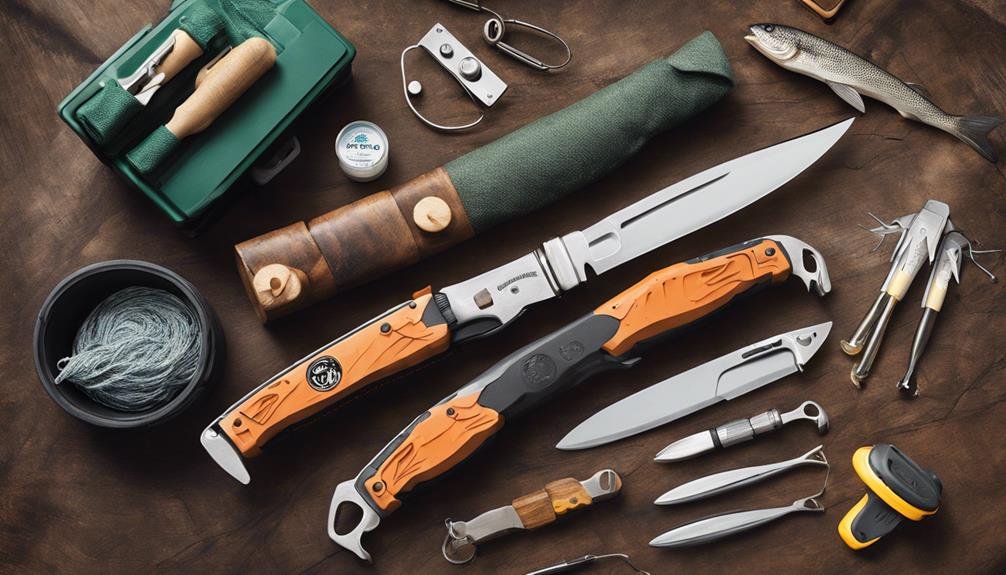
Enhance your fishing experience by incorporating essential accessories to elevate your efficiency and enjoyment on the water.
Consider adding a fillet glove to safeguard your hand while filleting fish. Keep your fishing knife safe and secure with a knife sheath or blade guard when not in use.
An electric knife sharpener is a valuable tool for quick and efficient sharpening. Additionally, having a portable knife sharpener in your tackle box guarantees on-the-go maintenance during fishing trips.
Utilize a cutting board designed for filleting to enhance stability and cleanliness while working with your fishing knife. These accessories have been tried and tested, providing convenience and functionality to make your fishing experience more seamless and enjoyable.
How can a secure knife attachment enhance the versatility of my fishing knife?
A secure knife attachment is crucial for enhancing the versatility of your fishing knife. It ensures the knife stays in place during use, providing safety and stability. Whether you are filleting a fish or cutting bait, the importance of secure knife attachment cannot be overstated.
Conclusion
As you navigate the waters of your fishing adventures, remember that your multi-functional fishing knife is like a trusty companion.
Just like seasoned anglers rely on their trusted rod and reel, harnessing the versatility of your fishing knife can make all the difference in your success on the water.
So sharpen your skills, keep your blade sharp, and embrace the convenience and efficiency of a well-maintained knife.
Happy fishing!
FAQs
What Is the Best Knife Shape for Fish?
When selecting the best knife shape for fish, choose a blade with flexibility and a narrow profile for precise cuts. A curved or pointed tip aids in piercing and skinning. Opt for a smooth, non-serrated edge to avoid tearing flesh. Guarantee the handle provides a secure grip, especially for slippery fish. Knife handle shapes vary, but prioritize comfort and control for a seamless filleting experience.
How Do I Keep My Filet Knife Sharp?
To keep your filet knife sharp, prioritize knife maintenance. Use honing steel at a 10-20 degree angle for regular upkeep. Consider carbide sharpening tools for effective edge restoration. Opt for knives with softer carbon steel for easier sharpening. Investing in quality honing steel is key for blade longevity. Regular maintenance guarantees peak performance when slicing and filleting your catch.
What Are the 2 Most Common Knives Used in Fish?
The two most common knives used when fishing are fillet and bait knives. Fillet knives have thin, flexible blades for precise cuts and bone removal. On the other hand, Bait knives are smaller and sturdier, ideal for cutting bait, lines, and tough materials. Knife materials play an essential role in their performance. Knowing the right knife for the task enhances your fishing experience.
What is the Best Tool for Sharpening Fillet Knives?
When sharpening fillet knives, carbide sharpening tools are your best bet. These tools are highly effective at removing material quickly, making them perfect for maintaining a precise 10-degree angle on your blade. Their versatility allows you to sharpen various types of fillet knife blades easily. After using a carbide sharpening tool, finish the process with honing steel for peak sharpness. This combination of sharpening techniques will keep your fishing knife performing at its best.
